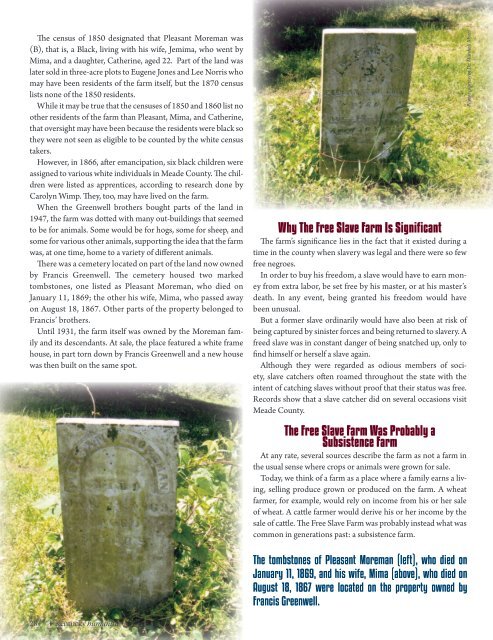Kentucky Humanities — Fall 2019
Timely, thoughtful and entertaining — a unique magazine about Kentucky’s people, culture and history. We are Telling Kentucky’s Story in each issue of Kentucky Humanities, a program of Kentucky Humanities.
Timely, thoughtful and entertaining — a unique magazine about Kentucky’s people, culture and history. We are Telling Kentucky’s Story in each issue of Kentucky Humanities, a program of Kentucky Humanities.
- TAGS
- humanities
- kentucky
You also want an ePaper? Increase the reach of your titles
YUMPU automatically turns print PDFs into web optimized ePapers that Google loves.
The census of 1850 designated that Pleasant Moreman was<br />
(B), that is, a Black, living with his wife, Jemima, who went by<br />
Mima, and a daughter, Catherine, aged 22. Part of the land was<br />
later sold in three-acre plots to Eugene Jones and Lee Norris who<br />
may have been residents of the farm itself, but the 1870 census<br />
lists none of the 1850 residents.<br />
While it may be true that the censuses of 1850 and 1860 list no<br />
other residents of the farm than Pleasant, Mima, and Catherine,<br />
that oversight may have been because the residents were black so<br />
they were not seen as eligible to be counted by the white census<br />
takers.<br />
However, in 1866, after emancipation, six black children were<br />
assigned to various white individuals in Meade County. The children<br />
were listed as apprentices, according to research done by<br />
Carolyn Wimp. They, too, may have lived on the farm.<br />
When the Greenwell brothers bought parts of the land in<br />
1947, the farm was dotted with many out-buildings that seemed<br />
to be for animals. Some would be for hogs, some for sheep, and<br />
some for various other animals, supporting the idea that the farm<br />
was, at one time, home to a variety of different animals.<br />
There was a cemetery located on part of the land now owned<br />
by Francis Greenwell. The cemetery housed two marked<br />
tombstones, one listed as Pleasant Moreman, who died on<br />
January 11, 1869; the other his wife, Mima, who passed away<br />
on August 18, 1867. Other parts of the property belonged to<br />
Francis’ brothers.<br />
Until 1931, the farm itself was owned by the Moreman family<br />
and its descendants. At sale, the place featured a white frame<br />
house, in part torn down by Francis Greenwell and a new house<br />
was then built on the same spot.<br />
Why The Free Slave Farm Is Significant<br />
The farm’s significance lies in the fact that it existed during a<br />
time in the county when slavery was legal and there were so few<br />
free negroes.<br />
In order to buy his freedom, a slave would have to earn money<br />
from extra labor, be set free by his master, or at his master’s<br />
death. In any event, being granted his freedom would have<br />
been unusual.<br />
But a former slave ordinarily would have also been at risk of<br />
being captured by sinister forces and being returned to slavery. A<br />
freed slave was in constant danger of being snatched up, only to<br />
find himself or herself a slave again.<br />
Although they were regarded as odious members of society,<br />
slave catchers often roamed throughout the state with the<br />
intent of catching slaves without proof that their status was free.<br />
Records show that a slave catcher did on several occasions visit<br />
Meade County.<br />
The Free Slave Farm Was Probably a<br />
Subsistence Farm<br />
At any rate, several sources describe the farm as not a farm in<br />
the usual sense where crops or animals were grown for sale.<br />
Today, we think of a farm as a place where a family earns a living,<br />
selling produce grown or produced on the farm. A wheat<br />
farmer, for example, would rely on income from his or her sale<br />
of wheat. A cattle farmer would derive his or her income by the<br />
sale of cattle. The Free Slave Farm was probably instead what was<br />
common in generations past: a subsistence farm.<br />
Photos courtesy of Dr. Marshall Myers<br />
The tombstones of Pleasant Moreman (left), who died on<br />
January 11, 1869, and his wife, Mima (above), who died on<br />
August 18, 1867 were located on the property owned by<br />
Francis Greenwell.<br />
28 <strong>Kentucky</strong> humanities




